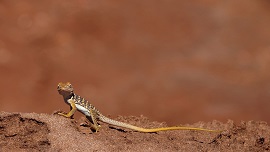Eastern Collared Lizard (Crotaphytus collaris collaris)
Description: These are relatively large lizards, with slender necks, large heads and long tails. There is a definite dimorphism in this species; males are larger and are often very brightly colored with yellow and orange bodies. The most noticeable characteristics of these lizards are found in the two black collars that run from the arms to the neck of the animal. Furthermore, there are usually six dark cross bands which run across the lizard's back. The bodies are usually covered with small white spots. Also, the scales on the lizard's body are granular, while the tail scales appear to be slightly larger.
Habitat: These lizards are found in a variety of habitats, ranging from arid areas with large rocks which are good for basking to hardwood forest regions. More frequently, however, they are found in hilly regions.
Range: Eastern collared lizards are found in areas between Kansas to northeastern Mexico, primarily in the central plains region, hilly or canyon lands which make up this particular part of the United States. In Texas, this species is found in the central to western regions.
Found in these States:
CO |
MO |
OK |
TX
Diet: The eastern collared lizard is an active predator. It feeds on a variety of arthropods and small lizards. While food sources vary, these lizards seem to prefer large grasshoppers for nutrition. In addition, spiders, moths, and beetles are also eaten. When the lizard preys on other lizards, it will kill them by crushing their skulls.
Reproduction: These lizards, like most other lizard speciess, are oviparous. They lay between 2-11 eggs in each clutch every yera. Under normal circumstances, breeding begins in May and continues through June. The eggs are ordinarily laid during July. In order to protect the eggs from predators, the lizards will bury them in loose sand and beneath the stones that they usually bask on .
Status: Crotaphytus collaris is assessed as Least Concern because this species is widely distributed and is represented by many stable populations. It faces no major threats at present.
»» Kingdom: Animalia - Animals
»» Phylum: Chordata - Chordates
»» Subphylum: Vertebrata - Vertebrates
»» Class: Reptilia - Reptiles
»» Order: Squamata - Lizards
»» Family: Crotaphytidae - Collarded & Leopard Lizards
»» Genus: Crotaphytus
»» Species: Crotaphytus collaris - Common Collared Lizard
»» Subspecies: Crotaphytus collaris collaris - Eastern Collared Lizard
This article uses material from the EOL article "Crotaphytus collaris collaris", which is released under the Creative Commons Attribution-Share-Alike License 3.0. Content may have been omitted from the original, but no content has been changed or extended.
|








